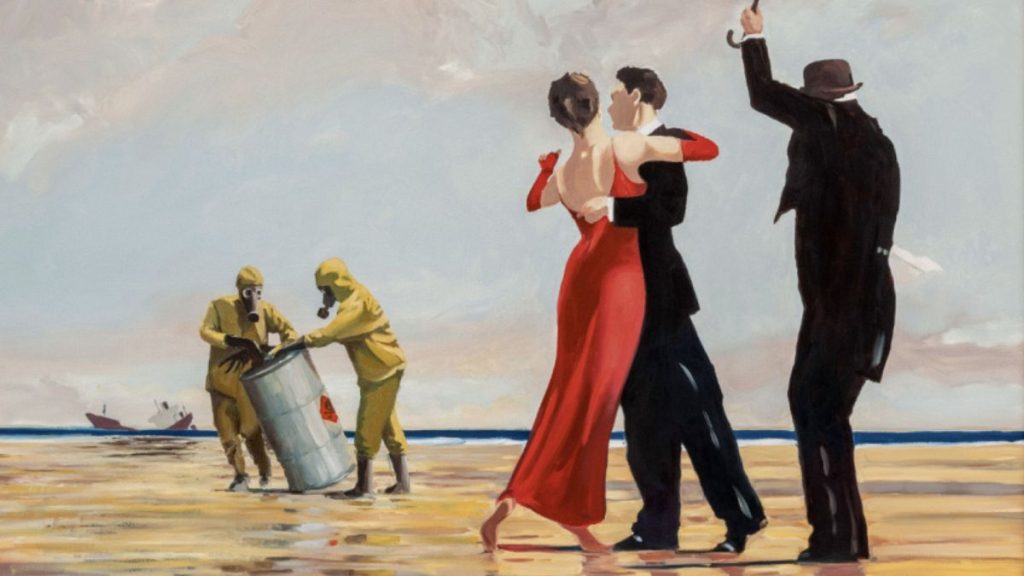In a recent high-profile auction, Mark Hoppus, the co-founder of the pop-punk band Blink-182, sold a significant artwork by the renowned graffiti artist Banksy for £4.3 million (€5.2 million). The piece, titled ‘Crude Oil (Vettriano)’, is a reimagining of the iconic painting ‘The Singing Butler’ created by Scottish artist Jack Vettriano. This sale not only highlights the increasing value of contemporary street art but also underscores Banksy’s sharp commentary on environmental issues, as illustrated through the symbolic alterations made to Vettriano’s original work.
| Article Subheadings |
|---|
| 1) The Artistic Journey of Banksy |
| 2) The Signature Work: ‘Crude Oil (Vettriano)’ |
| 3) Hoppus’s Connection to the Art |
| 4) Auction Details and Market Trends |
| 5) The Future of Street Art in Auctions |
The Artistic Journey of Banksy
Banksy, the elusive British street artist, has made a name for himself with his politically charged and socially relevant graffiti pieces that adorn walls globally. Emerging in the late 1990s, Banksy’s art often critiques consumerism, war, and environmental destruction. His identity remains largely a mystery, as he seldom appears in public and rarely reveals personal details, adding to the allure and intrigue surrounding his art. His works are not just meant to be visually striking; they carry deep messages about society and call for awareness and change.
The Signature Work: ‘Crude Oil (Vettriano)’
‘Crude Oil (Vettriano)’ was created in 2005 and presents a stark reinterpretation of Jack Vettriano‘s 1992 masterpiece ‘The Singing Butler’. In this artwork, Banksy replaces the original’s maid with two men in yellow hazmat suits, embodying a direct commentary on environmental degradation. Instead of a romantic seaside scene, the background now depicts a slick of crude oil, calling attention to the catastrophic impacts of pollution and corporate negligence. Banksy himself commented, “The real damage done to our environment is not done by graffiti writers and drunken teenagers, but by big business…” This piece exemplifies how art can transform familiar imagery into powerful social critiques.
Hoppus’s Connection to the Art
Mark Hoppus acquired ‘Crude Oil (Vettriano)’ in 2011, establishing a personal connection to the piece that transcended its aesthetic value. According to Hoppus, this artwork has been significant in his life, as he expressed, “We loved this painting since the moment we saw it… this painting has meant so much to us,” reinforcing the notion that art often evokes strong emotional responses and becomes intertwined with individual narratives. Hoppus’s experience illustrates the powerful bond between collectors and their artworks, which can represent more than just investment pieces, often serving as lasting memorabilia of personal journeys.
Auction Details and Market Trends
The auction held at Sotheby’s featured Hoppus’s piece along with other prominent modern and contemporary artworks. This particular auction saw ‘Crude Oil (Vettriano)’ expected to fetch between £3 million and £5 million (€3.6 million to €6 million). Ultimately, it achieved a final sale price of £4.3 million (€5.2 million), highlighting the skyrocketing values associated with Banksy’s works. The auction generated immense interest, reflecting broader trends in the market where street art — previously relegated to the margins — has now firmly established its place alongside traditional fine art. The growing acceptance and demand for such pieces signal a shift in taste and investment strategies among art collectors.
The Future of Street Art in Auctions
As street art continues to gain stature within the art world, its presence in major auction houses is likely to expand. The astronomical sale of works like Banksy’s ‘Love is in the Bin’, which sold for £18.6 million in 2021, sets a precedent for future auctions. Additionally, as artists who began their careers in street art move into more commercial spaces, the line between street art and traditional art is expected to blur further. Collectors are increasingly recognizing street art as a viable investment, reflecting deeper cultural conversations around authenticity, authorship, and value in the contemporary art market.
| No. | Key Points |
|---|---|
| 1 | Mark Hoppus sold a Banksy painting for £4.3 million at an auction. |
| 2 | The painting ‘Crude Oil (Vettriano)’ is a reinterpretation of Jack Vettriano’s work. |
| 3 | Banksy’s art often critiques environmental issues and corporate negligence. |
| 4 | The auction reflects rising values and interest in contemporary street art. |
| 5 | Street art is increasingly accepted in traditional art markets and auctions. |
Summary
The recent auction of Banksy’s ‘Crude Oil (Vettriano)’ emphasizes the growing intersection of popular culture and fine art, as exemplified by Mark Hoppus’s sale. This event not only highlights the economic viability of contemporary street art but also sheds light on the significant cultural narratives embedded in such works. As the art market evolves, it increasingly acknowledges the value and impact of artistic forms that challenge societal norms and reflect pressing global issues, thereby reshaping collectors’ perspectives and appreciation for art.
Frequently Asked Questions
Question: What is the significance of ‘Crude Oil (Vettriano)’?
‘Crude Oil (Vettriano)’ is significant as it critiques environmental degradation through its reimagining of a classic painting, highlighting the consequences of corporate negligence and pollution.
Question: How has street art evolved in the art market?
Street art has evolved to gain recognition and value within the traditional art market, with artists like Banksy leading the charge, as their works are increasingly sought after by collectors and investors.
Question: What does Mark Hoppus’s sale of the painting indicate about contemporary art collecting?
Mark Hoppus’s sale of the painting indicates that contemporary art collectors are increasingly interested in works that not only provide aesthetic value but are also intertwined with cultural and social narratives.


